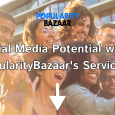When it comes to opinions, the most influential people in our lives are our family and friends. These are people we trust because we know them, and we know they understand our values. That’s why when a friend or family member recommends a product, at the very least, we listen. Smart companies understand how to leverage the recommendations of family and friends, and they do so with user-generated content. Rather than a brand putting out content with their product, the more powerful stuff comes from users of the product generating content about the product. People read reviews often – that’s one of the reasons for Amazon’s success – and these reviews are determinative or many decisions. When it is taken up a level to user-generated content, your brand will have greater engagement and success.
One of the most interesting things about user-generated content is that 76% of people in a survey said they trust the average customer to be honest about a product more than the brand itself. Clearly, this is an area where brands ahead of the curve will succeed. However, if you are wondering what is user generated content, the answer is that anything created by someone using your product is exactly what it is. There are several ways to empower users to create content helping your brand. When you harness the power of this content and roll out formal campaigns, what you are doing is taking yourself out of the message and letting the people who know your product as intimately as you sell it to those who are interested in possibly purchasing it. There are several ways to have a great user-generated content campaign, but here are some really excellent examples that worked out great for the companies using it.
UPS Store Reimagined

UPS recently ran a campaign with the hashtag #TheUPSStoreCustomer. The goal for the company was promoting people using the UPS store for their small business. Small businesses face challenges of shipping, among other things. This was an excellent way to promote the UPS store in a new light -as a business to business entity. Shipping is one of the biggest costs of doing business for a small business. The UPS Store with this campaign highlighted the different services provided by the store. There are also many other ways in which this hashtag worked so well. Because it was primarily used with Instagram, this allowed users to do video, use multiple pictures, or a story theme. Ultimately, this user-generated content campaign was successful because it showed the UPS store is a different light.
Working with a Different Kind of Buffer
It may not seem too interesting that Buffer is a social media scheduling service. In fact, let’s be really honest – this is not a very exciting service. This is why the people at Buffer had to do something attracting attention of others for their app and their service. With the understanding that the internet allows us to work on things where and how we want, Buffer decided to take it on the next step by doing something just completely not associated with its function at all – the hashtag #BufferCommunity.
The reason why this is a successful campaign is because Buffer’s Instagram account keeps sharing images with this hashtag. These images are of everyone and everything, but what they do is convey the message that with Buffer, you have the ability to work how you want and when you want. The unspoken message is loud and clear, also, with Buffer showing some amazing photos it appeals to the creatives looking for a scheduling app, as these are photos that are so creative and well done. This user-generated campaign content succeeded because it didn’t advertise the service explicitly.
Wayfair and the Power of a Testimonial

Getting the Wayfair jingle out of our heads has proven to be quite difficult – look, when you read the heading instinctively you hummed, “Wayfair’s got what I need.” The people running Wayfair are marketing geniuses because they do the simple things really well. Besides the jingle, there is the understanding of the power of testimonials. Except Wayfair doesn’t believe in just asking customers to tell people how great their products are, they want you to show it, and the way to show off is using the #WayfairAtHome hashtag.
There are some keys to success in these posts. The first is showing the items in the home and looking gorgeous. These posts nail that. The next thing is having the item names or sometimes even the links available from the users. This is something really simple and allows people to browse right after seeing the photo/testimonial. Since many people see themselves as designers, these tags bring ideas, and they allow Wayfair to cement their status as one of the top places to go for the best home décor. Because Wayfair does not have brick and mortar stores, this is also helpful because people see these design ideas in action in a way they would at a store. Since there’s no Wayfair store, it is brilliant for the company to rely on their users to essentially show off display models.
Showing off the Red Cups
Starbucks doesn’t need to do much to raise awareness for their holiday items. Revealing the Starbucks holiday cup is always an event, but the Red Cup challenge is something even better. Starbucks asks people to submit their photos featuring the red cups and the winning photos get a massive Starbucks gift card. While the red cup has to be purchased, the reality is this is a contest designed to appeal to Starbucks enthusiasts and is a great way for the brand to reward their loyal customers while giving people a chance to see the company’s wares in a completely different environment. Since the red cups are a high margin item, this is also a great way to get people in the stores for something else besides a latte and some of their other treats.









